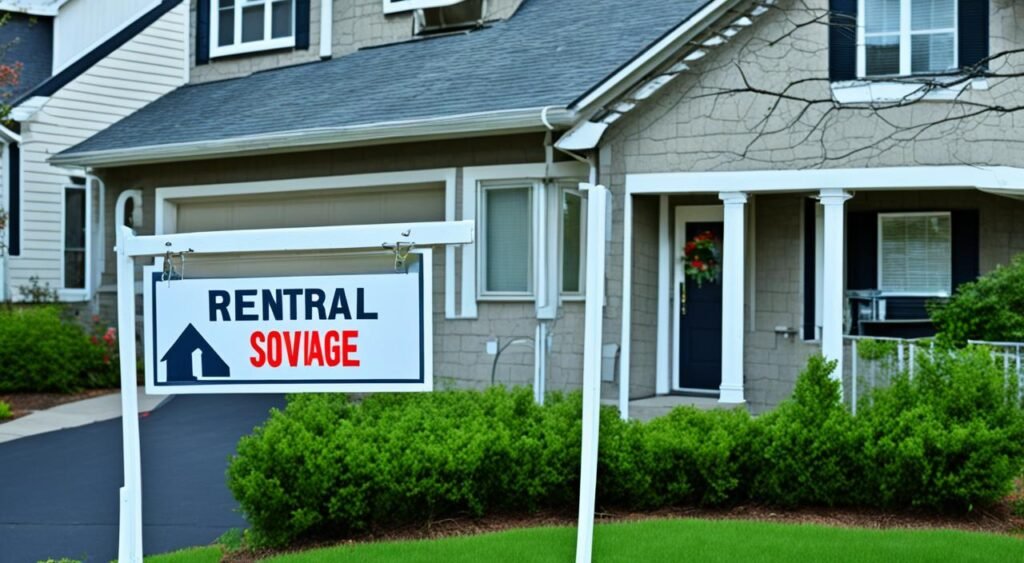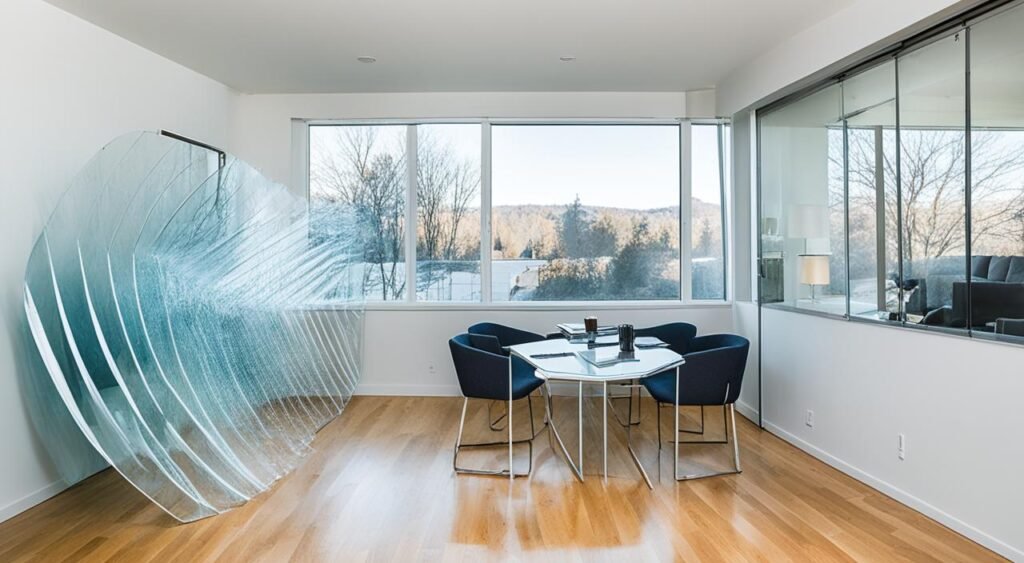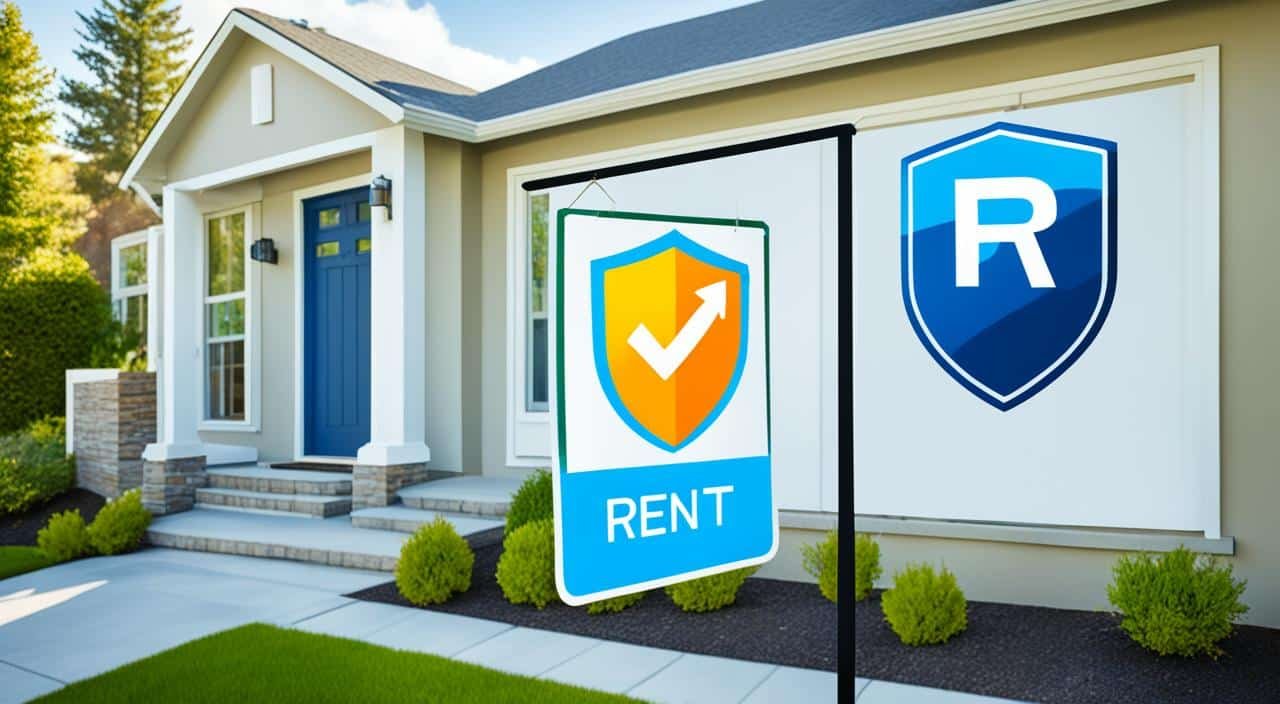property insurance for rental property: Protecting your rental property is key for any landlord. Rental property insurance, or landlord insurance, does just that. It guards you against the risks when renting your property. This is true whether it’s a house, an apartment, or a condo. The insurance ensures your investment is safe and keeps your rental income secure.
This insurance mainly covers three things. It helps with the property’s physical damage, any injuries or damage the tenants or their guests face, and lost income if your place becomes unlivable for a while. With this coverage, you can rest easy. You know your property and finances are safe.
Key Takeaways
- Rental property insurance, also known as landlord insurance, provides financial protection for landlords against risks associated with renting out their property.
- This type of insurance can cover damage to the physical structure of the property, liability for injuries or property damage, and lost rental income.
- Investing in rental property insurance can give landlords peace of mind and help safeguard their rental investment.
- Landlord insurance is typically required by mortgage lenders and can also help landlords comply with local laws and regulations.
- Understanding the specific coverage options and exclusions of a rental property insurance policy is important for landlords to ensure they have the right protection.
Understanding Rental Property Insurance
Rental property insurance is key for people who lease their houses or apartments. It protects against the special risks of renting out a place. The definition of rental property insurance explains it shields against damage, claims, and personal items loss.
Definition and Purpose of Rental Property Insurance
The main goal of landlord insurance is financial protection for property owners. It covers damages from fire, wind, theft, and vandalism. Also, it includes liability if a tenant gets hurt and protects the owner’s things in the rental property.
Risks Covered by Rental Property Insurance Policies
These policies guard landlords from many threats, such as:
- Dwelling coverage for the rental property’s structure
- Liability protection for tenant or guest injuries
- Personal property protection for the owner’s items at the rental
By knowing what rental property insurance covers, landlords can protect their investments. This helps avoid big financial losses.
Dwelling Coverage for Rental Properties

Rental property insurance includes a key part called dwelling coverage. It pays for repair costs if the property is damaged by wind, fire, or hail. This keeps the landlord safe from the big repair bills.
The coverage for rental homes is usually more than what’s in a standard homeowners policy. This is because fixing or replacing a rental often costs more. It is because the value of the property is higher than a regular home.
This protection helps with repairing or replacing the physical structure. It covers the roof, walls, and other parts that make up the property. Landlords don’t have to pay all the costs to fix their property if it is damaged.
It also covers permanent fixtures and installations like appliances and plumbing. This means built-in things are also protected. So, landlords can be sure their investment is safe against many types of damage.
“Dwelling coverage is the cornerstone of rental property insurance, providing essential protection for the building itself and the landlord’s investment.”
Understanding the importance of dwelling coverage is crucial for landlords. It ensures they have the coverage needed for their property. This way, they won’t have to bear the full cost of repairs if something bad happens. It lets them focus on making their rental business a success.
Liability Protection for Landlords
Being a landlord, it’s vital to have liability protection with your property insurance. This helps if a tenant or guest gets hurt on your property, or if your property damages someone else’s. If you’re found responsible, this coverage pays for their medical and legal bills. It also covers the costs for your own legal defense if you’re taken to court.
Coverage for Injuries and Property Damage
Liability insurance for landlords takes care of various incidents. It includes injuries like slip-and-fall accidents or dog bites. It also handles issues like property damage, such as fire or water damage, to other properties. Even personal injury claims against you are covered, such as libel or slander allegations.
Legal Defense Coverage
If a tenant or someone else sues you, your liability insurance covers your legal defense. This means it pays for your lawyer, court fees, and any settlements or judgments, up to your policy limits. Such protection can reduce your worries and prevent the heavy costs of dealing with a lawsuit.
| Coverage Type | Description |
|---|---|
| Liability Protection for Landlords | Covers injuries to tenants or guests, and property damage caused by the rental property |
| Legal Defense Coverage | Provides coverage for legal fees and court costs if the landlord is sued |
“Liability protection is a crucial safeguard for landlords, ensuring they are covered in the event of unexpected incidents on their rental property.”
Personal Property Protection

Rental property insurance helps protect what the landlord owns in the rental place. This can be appliances, lawn tools, and more meant for the renters. This protection is usually more than what’s in a basic homeowner’s policy. It considers how much these items are worth for keeping the property up.
This insurance covers things like furniture and appliances in the rental. It makes sure the landlord isn’t left paying for big losses like damage or theft. So, the rental can keep going smoothly and with everything it needs.
The great thing about this coverage is it’s not just for the building itself. It includes landlord-owned items protection. Things like outdoor tools and supplies for upkeep are covered. Landlords can feel secure, knowing they have personal property coverage for rental properties. It’s a backup plan for unforeseen events.
| Coverage Type | Homeowners Policy | Rental Property Policy |
|---|---|---|
| Personal Property | Limited coverage for items kept at the insured’s residence | Broader coverage for landlord-owned items at the rental property |
| Coverage Limits | Typically lower limits for personal property | Typically higher limits to account for the increased value of rental property items |
| Covered Perils | May have more exclusions and limitations | Often includes a wider range of covered perils, such as theft and vandalism |
“The personal property coverage in a rental policy is a crucial safeguard for landlords, helping to protect their investment and ensure their rental properties remain well-equipped and functional.”
Loss of Rental Income Coverage
Are you a landlord worried about rental income disruptions? Unexpected like fires or natural disasters can make your property unlivable. This means you might lose the money you count on. Loss of rental income coverage in your insurance can help during these tough times.
The goal of this coverage is to replace the missing rent. It helps while your place is fixed, making sure you’re not financially stressed. This way, you can keep up with landlord duties without worrying about lost income.
Loss of rental income coverage benefits landlords in several ways:
- Covers the rent you would normally get if your place wasn’t unlivable
- Keeps your cash flow healthy during repairs
- Offers protection for lost rent and coverage for uninhabitable properties
- Allows you to keep earning from rentals even when your place is unavailable
Add loss of rental income coverage to your insurance for peace of mind. It shields your investment and finances from unexpected rental halts.
“Rental property insurance with loss of income coverage is a must-have for any landlord. It provides the financial security you need to weather unexpected storms and continue generating rental income.”
Protect your rental business from setbacks by choosing the right insurance. This ensures your loss of rental income is covered. This way, your property can still be a reliable income source in challenging times.
| Coverage | Description |
|---|---|
| Loss of Rental Income | Covers the rent you would have collected if your property was not damaged and inhabitable, providing financial protection during the repair process. |
| Protection for Lost Rent | Ensures you can continue earning rental income even when your property is temporarily unavailable due to a covered incident. |
| Coverage for Uninhabitable Properties | Provides financial support to cover the lost rental income if your property becomes uninhabitable, allowing you to meet your financial obligations as a landlord. |
Exclusions and Limitations
Understanding what rental property insurance doesn’t cover is vital. This knowledge can affect your financial safety as a landlord. It points out the items that your insurance won’t pay for.
Tenant’s Personal Property
Rental property insurance doesn’t cover your tenants’ personal items. It focuses on the building’s structure and the landlord’s belongings. Tenants should get their own renters insurance to protect their possessions. So, if a tenant’s things get lost or damaged, it’s not your insurance’s job to pay for it.
Maintenance and Equipment Failure
Expect your insurance not to help with maintenance and equipment breakdowns. As a landlord, it’s your duty to keep the property in good shape. This includes making sure systems like heating and cooling work.
If systems or appliances fail from use, your insurance won’t help fix or replace them. Such issues are seen as part of a landlord’s job. They are not covered by rental property insurance as standard.
Getting to know your insurance’s fine print is wise. It helps in making sure you’re protected and lessening the risks of renting out property.
property insurance for rental property
Looking into rental property insurance? You’ll see ‘DP1, DP2, and DP3,’ a coverage ranking system. It’s key for landlords wanting to keep their property safe and their tenants secure.
DP1 is a basic, wallet-friendly option. It covers for dwelling, liability, and lost rent. Meanwhile, DP2 policies protect more, including extra structures like garages or sheds. DP3 offers the top protection for your rental home and related liabilities.
Most DP2 and DP3 plans also include coverage for lost rent. If your rental becomes unlivable due to a disaster, this helps cover your lost income. This feature is key for landlords, keeping their cash flow steady even in setbacks.
| Coverage Type | DP1 | DP2 | DP3 |
|---|---|---|---|
| Dwelling | ✓ | ✓ | ✓ |
| Additional Structures | – | ✓ | ✓ |
| Liability | ✓ | ✓ | ✓ |
| Loss of Rent | ✓ | ✓ | ✓ |
| Loss of Use | – | ✓ | ✓ |
Choosing rental property insurance? It’s a must to think about what you need and can afford. This way, you pick the right landlord insurance. Knowing the different coverages of DP1, DP2, and DP3 helps you protect your rental the right way.
Additional Coverage Options

Rental property insurance often includes extra coverages you can add. These can protect against more risks for landlords. They go beyond the usual coverage for the building, liability, and personal items.
Vandalism and Burglary Protection
One added protection is for vandalism and burglary. It covers the cost of fixing damage from vandalism or break-ins. This is key, especially when your property is empty for a long time.
Building Code Compliance Coverage
Another option is building code compliance coverage. This helps with needed property upgrades after a loss. It makes sure your property meets safety and regulatory standards, keeping its value and safety.
Looking at these extra coverages can help landlords better protect their properties. It prepares them for more risks and issues that might come up.
| Coverage Option | Description | Key Benefits |
|---|---|---|
| Vandalism and Burglary Protection | Covers the costs of repairing intentional damage to the rental property caused by acts of vandalism or break-ins. | Protects the property from malicious damage, especially when unoccupied for extended periods. |
| Building Code Compliance Coverage | Helps pay for any necessary upgrades or modifications to the property that are required by local building codes when making repairs after a covered loss. | Ensures the property remains in compliance with safety and regulatory standards, preserving the value and safety of the rental investment. |
Adding these insurance options improves a landlord’s property protection. It gets them ready for more risks and challenges.
Cost Considerations for Rental Property Insurance

When getting insurance for your rental, the cost is a key thing to think about. It’s usually 15-20% more than insuring your own home. This is because renting your place out comes with different risks.
The price you pay for insurance on your rental is influenced by a few things:
- Location of the property – Property locations with more crime or natural disasters can raise your cost.
- Age and condition of the building – If your place is older or needs fixing, it could cost more to insure.
- Level of coverage selected – Picking higher coverage limits means you’ll pay more.
- Landlord’s claims history – Past claims you’ve made can also affect your premium.
For a rental with $400,000 in coverage for the home and $100,000 for liability, you might pay between $1,106 and $3,505 per year. This is against a homeowners policy, which could run from $962 to $2,921 for the same property.
| Coverage Type | Average Annual Cost |
|---|---|
| Rental Property Insurance (400K dwelling, 100K liability) | $1,106 – $3,505 |
| Homeowners Insurance (Same Property) | $962 – $2,921 |
Deciding if rental insurance is worth the cost is crucial for landlords. Analyzing what affects the premium helps in making smart choices. This way, you can protect your investment wisely.
“Protecting your rental property with the right insurance coverage is essential to safeguarding your investment and avoiding costly out-of-pocket expenses.”
Also Read: Home Insurance Guide: Unique Challenges and Solutions While Insuring Your Tiny Home
Conclusion
Renting a property is a wise choice, but it’s not without its risks. Landlords must think carefully about insurance. It helps protect their investment, deal with financial risks, and keep their income steady. Knowing why rental property insurance is vital, landlords can make sure their business stays successful.
It’s key for landlords to protect their investment against tenant issues, property damage, and liability claims. The right insurance means they can handle these challenges well. It also shows they are serious about managing their properties responsibly. This can make tenants, both current and future, trust them more.
So, rental property insurance is a must for handling risks. Landlords need to look into what different policies offer, what they don’t cover, and how much they cost. This way, they can choose a plan that meets their property’s unique needs. Investing in the right insurance is a smart move for steady rental income and protecting valuable real estate.
FAQs
What is rental property insurance?
Rental property insurance, or landlord insurance, protects property owners when they rent out their places. It covers damage, liability claims, and lost rental income.
What types of coverage does rental property insurance provide?
Coverage includes benefits for property damage, liability, and personal property at the site. It also covers lost rental income if the property can’t be used.
How does rental property insurance differ from standard homeowners insurance?
This insurance is for landlords facing different risks than a homeowner would. It has specific higher coverage limits for their unique needs.
What are the exclusions and limitations of rental property insurance?
It doesn’t cover a renter’s personal items or the costs of wear and tear’s maintenance. These are the renter’s or landlord’s duties, respectively.
What are the different types of rental property insurance policies?
You can pick from DP1, DP2, or DP3 policies. DP3 has the most coverage. DP2 and DP3 might also have extra options like loss of use and keeping up with building codes.
How much does rental property insurance cost?
It normally costs 15-20% more than homeowners insurance. The price depends on where the property is, its condition, how much coverage you want, and your claims history.





